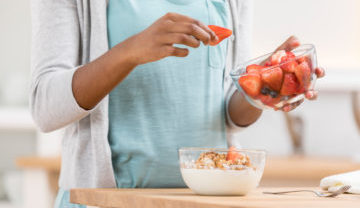Healthy Eating
You Are What You Eat and Drink
Food is more than just fuel for your body. It affects your overall health and growth, and even how you feel. It can comfort you, bring you pleasure, or reveal how your family shows love. Not enough food may lead to feeling “hangry,” while too much food can make you sick. Creating healthier habits around what you eat and drink will help boost your energy and confidence, and maintain a healthy weight.
Portions and Colors–Your Plate Can Guide You
An easy way to manage portions and eat foods that are healthier for you is to use your plate as a guide. Fill half your plate with vegetables, one fourth with protein, and the other fourth with starch. Add fruit for dessert or eat as snacks.
For healthy eating, go for a colorful plate. Dark green, red, orange, and yellow vegetables and fruit have high levels of vitamins, calcium and fiber. Eat a variety of lean protein choices like beans, fish, tofu, or chicken. Choose low-fat dairy options, like Greek yogurt, for extra protein. For the starch section, switch to complex carbohydrates and whole grains for an extra dose of fiber and nutrients. This includes 100% whole wheat bread and pasta, corn tortillas, oatmeal, quinoa, sweet potatoes, and whole grain cereal. If you like dairy, choose skim or 1% milk or switch to plant-based options like almond, soy, or oat milk.
Here are a few tips for healthy eating:
- Eat food prepared at home as much as you can. Fast food and takeout tends to be higher in salt and fat. Calories are also usually much higher than you think! If you do go out to eat, go for pizza with veggies instead of meat, or get the small sandwich and fries with water instead of soda.
- For a quick snack, try a pear, apple or banana; yogurt with berries; hummus with sliced veggies; string cheese with whole grain crackers; air-popped popcorn; or a small handful of unsalted nuts and dried fruit.
- Try to limit foods like cookies, candy, frozen desserts, chips and fries, which often have a lot of added sugar, fat and salt. They’re great for an occasional treat, just not every day!
- Drink more water. Sugary drinks like soda, lemonade, sweet tea, and fruit juices have a lot of added sugars, which add up to extra calories. Try water, seltzer, unsweetened tea or low-fat milk instead.
- Eat breakfast! Eating a healthy breakfast will give you more energy and help you avoid that hungry headache. Plan out what you’ll eat the night before. If you don’t have time for a bowl of oatmeal or a veggie omelet, take a granola bar and a piece of fruit with you.
- Have lunch. Skipping lunch can cause you to overeat at your next meal because you’re so hungry. Bring a sandwich and a piece of fruit if you can, or you can make healthy choices at your school cafeteria or a neighborhood store. For more healthy lunch ideas and info about what skipping lunch does to your body, check out this article.
- Portion control: Most of us aren’t good at eyeballing portions of food. Portion sizes in restaurant and fast food meals are much larger than what most people need to eat. Sometimes they provide a whole day of calories in only one meal. A good way to estimate a more healthful portion is to use your hand!
- The palm of your hand is a good guide to one serving of protein like chicken, fish, beef, or pork. That’s about 3 ounces.
- The size of your fist is equivalent to one cup of fruit, vegetables, dry cereal, yogurt, or milk.
- The size of your fist is a measure for one serving of noodles, potatoes or rice, about ¾ to 1 cup.
Finding and Preparing Healthy Foods
Many neighborhoods do not have easy access to a grocery store. People who live there may have to travel a long way on public transit or rely on bodegas or other small corner stores to get nutritious food to prepare. These neighborhoods are known as “food deserts.”
The good news is New York and some other states are working to get grocery chains to expand into underserved communities and to offer farmer’s markets in more neighborhoods. There already may be a farmers’ market in your neighborhood! If your family has SNAP or WIC benefits, you can use a portion of this money at farmers’ markets across the city. If your family sometimes runs out of money, free food and assistance is available at food pantries and soup kitchens, as well as schools and after school programs.
True, finding fresh, wholesome food takes time and money. It may also require cooking! TeensHealth on kidshealth.org has a lot of tasty, easy recipes for teens with all kinds of nutritional needs, including diabetes, lactose intolerance, and weight management, as well as cooking basics! Your body will thank you for making the effort to feed it well.
Resources
Some of these tips are from NIDDK’s Take Charge of Your Health: A Guide for Teens, which has lots of info about healthy foods and drinks and other healthy habits.
Have questions about how to be your healthiest self? If you live in the NYC area and you’re 10-26 years old, call Mount Sinai Adolescent Health Center for a free, confidential visit with a health care provider and registered dietitian. Our Teen Fit program combines exercise, nutrition education and mental health services to help young people practice the skills needed to support a healthy body and mind.
This information is not intended to provide medical advice, professional diagnosis, opinion, treatment or services, only general information for education purposes only.


